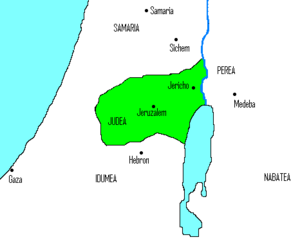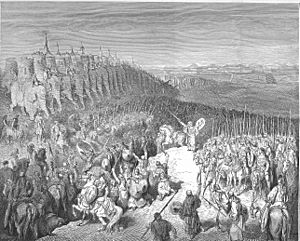Judas Maccabeus facts for kids
Quick facts for kids Judas Maccabee |
|
|---|---|
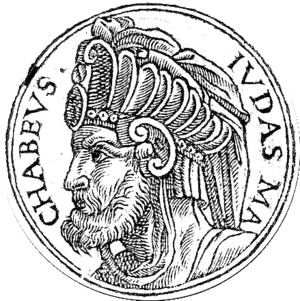
An imaginary depiction of Judas Maccabeus from Guillaume Rouillé's Promptuarii Iconum Insigniorum (1553)
|
|
| Leader of the Maccabees | |
| Predecessor | Mattathias |
| Successor | Jonathan Apphus |
| Died | 160 BCE |
| Dynasty | Hasmonean |
| Father | Mattathias |
Judah Maccabee (also known as Judas Maccabeus) was a brave Jewish priest and a leader. He was the son of Mattathias, who started a big fight for freedom. Judah led the Maccabean Revolt against the Seleucid Empire from 167 to 160 BCE.
The Jewish holiday of Hanukkah is celebrated every year to remember a special event from Judah's time. In 164 BCE, Judah Maccabee and his followers cleaned and rededicated the Second Temple in Jerusalem. This was after it had been used for Greek gods. Hanukkah means "Dedication," and it celebrates this important moment.
Judah Maccabee's Life
His Early Years and the Start of the Revolt
Judah was the third son of Mattathias, a Jewish priest from a village called Modi'in. In 167 BCE, Judah, his father, and his brothers (Eleazar, Simon, John, and Jonathan) began a rebellion. This was against the Seleucid Empire and its ruler, Antiochus IV Epiphanes.
Antiochus had made rules that stopped Jews from practicing their religion. After his father Mattathias died in 166 BCE, Judah took over as the leader of the revolt. People admired Judah's courage and his skills as a military leader. This made him the clear choice to lead the fight for freedom.
Why Was He Called "The Hammer"?
Early in the rebellion, Judah earned the nickname "Maccabee." This name might come from an Aramaic word meaning "hammer" or "sledgehammer." People think he got this name because he was so fierce and powerful in battle, like a hammer. Some also believe it was because of his favorite weapon.
Another idea is that Maccabee is a acronym from a Hebrew phrase, Mi kamokha ba'elim Adonai, which means "Who among the gods is like you, O Adonai?" This was a battle-cry used to inspire the troops. While the name first belonged only to Judah, it later became a name for all the Hasmonean family who fought in the revolt.
Judah's First Victories
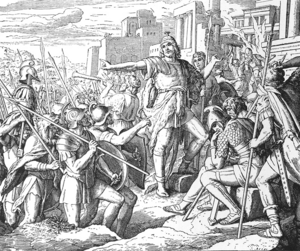
Judah knew the Seleucid army was much stronger at first. So, he used a smart strategy: guerrilla warfare. This meant avoiding big battles and making surprise attacks. This made the enemy feel unsafe and helped Judah win many early victories.
He defeated a small Seleucid force near Nahal el-Haramiah. Their commander, Apollonius, was killed, and Judah took his sword as a symbol of revenge. After this win, many more people joined Judah's cause.
Soon after, Judah defeated a larger Seleucid army near Beth-Horon. He chose the battlefield wisely, which helped his smaller army win. Then, at the Battle of Emmaus, Judah outsmarted the Seleucid generals Nicanor and Gorgias. He tricked them by moving his troops at night and then attacked their camp by surprise. The Seleucid commander had to retreat.
These defeats convinced the Seleucid leader, Lysias, that he needed to prepare for a serious war. He gathered a huge new army and marched towards Judea.
Recapturing Jerusalem and Hanukkah
After several years of fighting, Judah drove his enemies out of Jerusalem. The only part they still held was the fortress called Acra. Judah then cleaned and purified the Temple of Jerusalem, which had been defiled. On December 14, 164 BCE, he brought back the Temple service.
This event, the rededication of the Temple, became a lasting Jewish holiday: Hanukkah. It is still celebrated every year. Taking back Jerusalem was a big step towards Jewish independence.
Fighting Beyond Jerusalem
When Judah heard that Jewish communities in other areas like Gilead and Galilee were being attacked, he quickly went to help. He sent his brother, Simeon, to Galilee, where Simeon won many battles. Simeon also moved many Jewish families, including women and children, to the safer region of Judea.
Judah himself led a campaign in Transjordan. After tough fighting, he defeated the local tribes and rescued Jews who were trapped in fortified towns. He also fought against the Edomites in the south, capturing and destroying cities like Hebron. Judah then marched to the coast, destroyed pagan altars in Ashdod, and returned to Judea with many valuable items.
Judah then began to besiege the Seleucid garrison in the Acra fortress in Jerusalem. The soldiers inside, who included both Syrian-Greek troops and some Jews who supported Greek culture, asked Lysias for help. Lysias was now in charge of the young king Antiochus V Eupator.
Lysias and Eupator started a new campaign in Judea. They attacked Beth-Zur. Judah stopped his siege of the Acra to meet Lysias. In the Battle of Beth-zechariah, the Seleucids won their first major victory over the Maccabees. Judah had to retreat to Jerusalem. Beth-Zur surrendered, and Lysias began to besiege Jerusalem.
The defenders in Jerusalem were in a difficult spot because they were running out of food. It was a sabbatical year, meaning the fields were not farmed. However, just when it seemed they might have to give up, Lysias and Eupator had to leave. This was because Philip, another general, was rebelling against Lysias back in Antioch.
Lysias offered a peace deal, which was agreed upon in late 163 BCE. This agreement brought back religious freedom for the Jews, allowed them to live by their own laws, and officially returned the Temple to them. Lysias defeated Philip, but then a new king, Demetrius I Soter, took over. Demetrius appointed Alcimus, a Hellenist Jew, as the new high priest.
Internal Conflicts and More Battles
After the war against the outside enemy ended, a new struggle began among the Jews themselves. This was between Judah's group and the "Hellenist" group, who favored Greek culture. The Hellenist high priest, Menelaus, was removed and killed. His replacement was another Hellenist, Alcimus.
When Alcimus killed sixty priests who disagreed with him, he came into open conflict with the Maccabees. Alcimus fled Jerusalem and asked the Seleucid king, Demetrius, for help. Demetrius sent an army led by Bacchides to Judea. Judah's smaller army could not fight them directly and went back to using guerrilla tactics.
Soon, the Seleucid army had to return to Antioch because of political problems there. Judah's forces returned to Jerusalem. The Seleucids then sent another army, again led by Nicanor. In a battle near Adasa, on March 13, 161 BCE, the Seleucid army was destroyed, and Nicanor was killed. A special day, "Day of Nicanor," was created to remember this victory.
Agreement with Rome and Judah's Death
Judah Maccabee made an agreement with the Roman Republic in 161 BCE. This was the first recorded agreement between the Jewish people and the Romans.
However, this agreement didn't stop Demetrius. When he heard about Nicanor's defeat, he sent a new army, again led by Bacchides. This time, the Seleucid forces were much larger, with 20,000 men. Most of Judah's soldiers left the battlefield, telling him to do the same and wait for a better chance. But Judah decided to stay and fight.
In the Battle of Elasa, Judah and his loyal followers were killed. His brothers took his body from the battlefield and buried him in the family tomb at Modiin. Judah Maccabee's death in 160 BCE inspired the Jews to keep fighting for their freedom. After several more years of war, led by Judah's brothers Jonathan and Simon, the Jews finally achieved independence and the right to worship freely.
Judah Maccabee in Art and Music
Stories and Plays
Judah Maccabee has been a hero and an inspiration for many writers, artists, and composers throughout history. In the famous poem The Divine Comedy, Dante sees Judah's spirit among the heroes of faith.
Many works have been created about him since the 17th century. The Spanish playwright Pedro Calderón de la Barca wrote an early play called Judas Macabeo. Handel composed his famous Judas Maccabaeus oratorio in 1746.
In the 19th century, Henry Wadsworth Longfellow wrote a five-act play called Judas Maccabaeus (1872). Other stories include Judas Makkabaeus by Josef Eduard Konrad Bischoff and The Hammer by Alfred J. Church.
Many Jewish authors in the 20th century also wrote about Judah Maccabee and the revolt. These include poems, dramatic works, and children's plays. Howard Fast wrote a historical novel called My Glorious Brothers in 1948. During World War II, a Swiss-German writer published a novel that compared Judah Maccabee's fight for freedom to the struggles of small nations.
Visual Arts
In medieval Christian art, Judah Maccabee was seen as an Old Testament hero. There are illustrated manuscripts and paintings showing him. Rubens painted a scene of Judah Maccabee praying for the dead, which was used to explain the idea of purgatory during the Counter-Reformation. In the 19th century, Paul Gustave Doré created an engraving of Judah Maccabee winning a battle.
Music
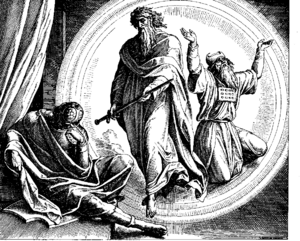
Many musical pieces have been inspired by Judah. Handel's 1746 oratorio Judas Maccabeus is one of the most famous. Its well-known chorus, "See, the conqu'ring hero comes," is now also a Christian Easter hymn and a popular Hanukkah song in Israel. Beethoven even composed variations on this tune.
Modern musicians like Tom Lehrer and Mirah have also referred to Judah Maccabee in their songs.
See also
 In Spanish: Judas Macabeo para niños
In Spanish: Judas Macabeo para niños
- Jewish leadership
- List of Hasmonean and Herodian rulers
- Nine Worthies
Images for kids


